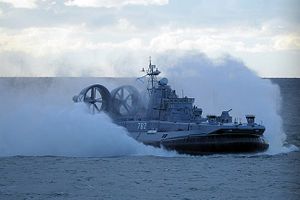A host of Chinese landing crafts and assault vehicles were unable to breach the defenses and establish a beachhead on an island during a recent amphibious assault drill conducted in the South China Sea due to “effective measures” by the defending forces, Chinese Central Television (CCTV) lamented, according to defenseworld.net.
All hopes of victory were lost until the People’s Liberation Army Navy (PLAN) decided to send in its newest weapon, the Zubr-class air cushioned landing craft (LCAC), a move that (surprise! surprise!) ended up turning the tide and winning the day for the assault force.
“The CCTV report described the exercise as testing the PLAN’s ability to land an amphibious assault force in collaboration with other parts of the armed forces. Screen grabs from the report show what appears to be a PLA Type 99 main battle tank (MBT) emerging from the LCAC,” is IHS Janes 360’s sober assessment of the military drill.
Displacing 550 tons when fully loaded and measuring 57 meters (187 feet) long and 26 meters (84 feet) wide, the Soviet-designed hovercraft is the world’s largest. It can carry up to three main battle tanks, or ten armored personal carriers with 230 troops, or 375 fully equipped troops in its cargo compartment and land its deadly load on just about any landmass.
The Zubr-class LCAC can withstand small arms fire and shrapnel due to its light armor and also sports a formidable defense system that includes air defense missiles, 30mm cannons, and rocket launchers. The LCAS is specifically designed to circumvent magnetic influence mines and is equipped with electronic countermeasures to evade anti-ship missiles.
The ship is powered by five Kuznetsov NK-12 gas turbines and has a cruising speed of 30 to 40 knots. Its crew consists of four officer and around 30 sailors.
In 2009, the PLAN procured four Zubr-class LCACs from Ukraine – the first two built on the Crimea Peninsula at the Feodosia Shipbuilding Company with the second pair license-built in China – for an estimated $350 million.
However, according to Foxtrot Alpha, China is looking to put the Zubr-class in serial production with a new indigenous defense system and various other improvements. While the Zubr-class will in all likelihood be available on the international arms export market, additional vessels will also probably be inducted into the PLAN over the next few years, closing a critical amphibious assault capability gap.
The LCAC has a range of 480km (300 miles), which makes it ideally suited for operations on the islands in the South China Sea. Consequently, a number Zubr-class vessels will almost certainly be stationed on Hainan Island – home of China’s South Fleet.
Tyler Rogoway over at Foxtrot Alpha neatly summarizes the importance of the Zubr-class LCAC for the PLAN:
(..)[W]hat the Zubr Class offers the Chinese Navy is a unique access and striking capability that is perfectly fitted to the territorial claims that China has clearly made. The ability to travel long distances at high speed with a large cargo load, and to be able to access almost any landmass without any prevailing infrastructure to convey that cargo, is a capability that no watercraft but the Zubr Class can offer.
































